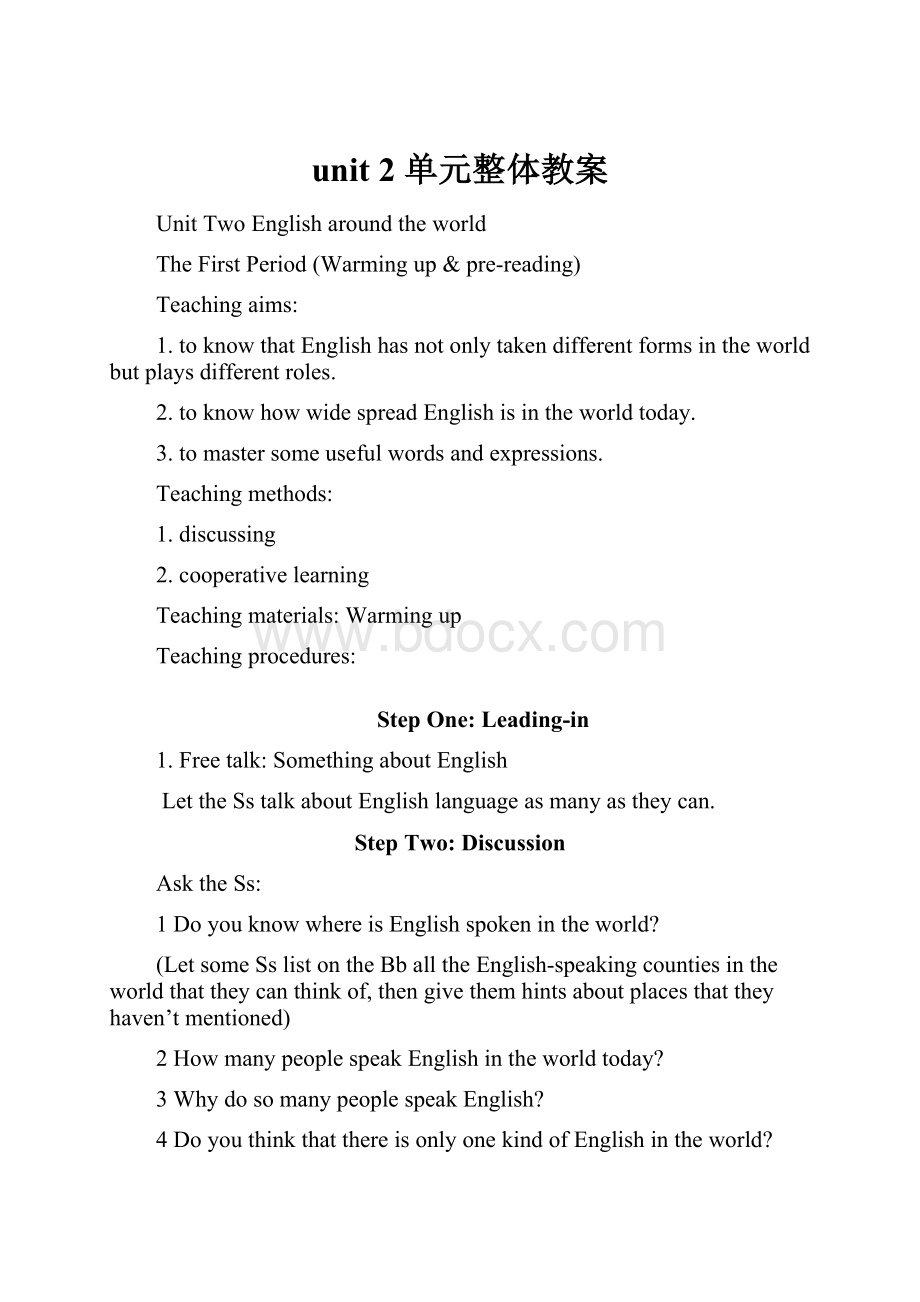unit 2 单元整体教案.docx
《unit 2 单元整体教案.docx》由会员分享,可在线阅读,更多相关《unit 2 单元整体教案.docx(13页珍藏版)》请在冰豆网上搜索。

unit2单元整体教案
UnitTwoEnglisharoundtheworld
TheFirstPeriod(Warmingup&pre-reading)
Teachingaims:
1.toknowthatEnglishhasnotonlytakendifferentformsintheworldbutplaysdifferentroles.
2.toknowhowwidespreadEnglishisintheworldtoday.
3.tomastersomeusefulwordsandexpressions.
Teachingmethods:
1.discussing
2.cooperativelearning
Teachingmaterials:
Warmingup
Teachingprocedures:
StepOne:
Leading-in
1.Freetalk:
SomethingaboutEnglish
LettheSstalkaboutEnglishlanguageasmanyastheycan.
StepTwo:
Discussion
AsktheSs:
1DoyouknowwhereisEnglishspokenintheworld?
(LetsomeSslistontheBballtheEnglish-speakingcountiesintheworldthattheycanthinkof,thengivethemhintsaboutplacesthattheyhaven’tmentioned)
2HowmanypeoplespeakEnglishintheworldtoday?
3WhydosomanypeoplespeakEnglish?
4DoyouthinkthatthereisonlyonekindofEnglishintheworld?
(TelltheSsthatEnglishhasavarietyofspokenandwrittenforms,andtherearetwomajorgroupsofEnglish:
BritishEnglishandAmericanEnglish.)
StepThree:
Guessanddiscuss
1.HavetheSsguesswhichofthefollowingwordsisBritishEnglishandwhichisAmericanEnglish:
(前美后英)
elevator/liftonateam/inateameraser/rubber
gas/petrol
2.GiveSsafewoftheBritishEnglishwords,letthemdiscussinpairsandtrytoguesstheBritishEnglishequivalents.
E.g..pub:
barmad:
crazyautumn:
fall
mend:
repairpost:
mailfilm:
movie\film
ill:
sicklorry:
truckmatch:
game
StepFour:
Languagepoints:
1insomeway在某些方面
e.g.Insomeway,it’sgood,butit’sexpensive.
词组联想:
onthe\one’swayto在去……的路上
intheway挡路
innoway决不
inaway在一定程度上
bywayof经由……
2because+从句
becauseof+名词/代词
E.g..Wewerelatebecauseitrained.
Theyareherebecauseofus.
StepSix:
Assignments
1.AskSstogivemorewordsthatarespokenorwrittenindifferentforms.
2.PrepareforReading
TheSecondandThirdPeriod
(readingandcomprehending)
Teachingaims:
1.toknowabouthowEnglishdeveloped----abriefhistoryoftheEnglishlanguage
2.topromotetheSs’abilitiesofreadingcomprehension
3.tolearnaboutsomenewlanguagepoints
Teachingmethods:
1.readinganddiscussion
2.cooperativelearningandspeaking
Teachingmaterials:
Reading,Comprehending
Teachingprocedures:
StepOne:
Leading-in
T:
English,likeallmajorworldlanguages,itisconstantlychanging.DoyouknowthebriefhistoryoftheEnglishlanguage?
StepTwo:
Reading
1.AsktheSstoskimthepassageandanswerthefollowingquestions:
Whatdoesthepassagemainlytalkabout?
WhichcountryhasthelargestnumberofEnglishspeakers?
(China)
WhyhasEnglishchangedovertime?
(Paras3-4)
2.LettheSsreadthepassageandgivethemainideaforeachparagraph.
Pare1:
It’saboutthenumberofthepeoplewhospeakEnglish.
Pare2:
NativeEnglishspeakerscanunderstandeachother,butmaynotbeabletounderstandeverything.
Para3-4:
(Thesecondsentence)
Pare5:
EnglishisalsospokenasaforeignorsecondlanguageinAsiaandAfrica.
(仅供参考)
StepThree:
Discussion
1.HaveSsconsideranddiscusshowmuchtheirlivesmaychangeEnglishinthefuture?
2.LetSspredicttheroletheirgenerationwillplayinthedevelopmentoftheEnglishlanguage.
StepFour:
Listentothetextandthengothroughitwiththewholeclass.
StepFive:
Languagepoints
1.evenif=eventhough:
inspiteofthefact;nomatterwhether即使;尽管。
引导让步状语从句。
Evenifwehavelearned“eventhough”,westillfinditdifficulttouse.
Helikestohelpuseventhoughheisverybusy.
EvenifIhavetowalkallthewayI’llgetthere.
2.howeveradv.conj.
表示“然而、可是”。
可放在句首、句尾,也可插在句中,其后一般要用逗号。
E.g..Itlookedlikearain.However,itisclearthismorning.
Hesaidthatitwasso;hewasmistaken,however.
3.Not…everything“并非一切都”
1)否定词not与all,both,every及其复合词(everything,everybody,everywhere)等词连用,一般来说表示不完全否定。
E.g.Alltheboysdon’tlikefootball.=Notalltheboyslikefootball.
(Someboyslikefootballbutsomeofthemdon’t.)
Bothoftheanswersarenotright.(Oneofthetwoanswersiswrong.)
2)否定词not与表频率的副词always连用时(notalways=sometimes)例如:
E.g.Idon’talwaystellthemthatthey’vemadeamistake.我并不总是同他们说他们弄错了。
Heisn’talwayslateforschool.他也不是上课老迟到。
3)含有seldom,hardly,little,few等准否定词的句子也应属于部分否定范围。
E.g.Youhavedonelittleforus.你几乎没为我们干什么。
Veryfewpeopleunderstoodwhathesaid.几乎没人懂他的话。
4.comeup走近;上来
E.g.Hecameuptotheyoungladyoverthereandstartedtalkingtoher.
comeupwith提出
comeabout发生
comeout出版;出现;显露出来
comeacross偶然碰上
E.g.Hecameupwithanewsuggestion.他提出了一项新的建议。
HowdidthedifferencesbetweenBritishEnglishandAmericanEnglishcomeabout?
英国英语和美国英语之间的不同是怎样形成的?
Whenwillyourbookcomeout?
你的书什么时候出版?
5.over:
throughout(aperiod);during贯穿(一时间段)
E.g.Overtheyearshehasbecomemorepatient.这几年他越来越有耐心。
Rickcametotownovertheweekend.瑞克周末到城里来过。
6.basesth.onsth.以某事物为另一事物的根据、证据等
E.g..Hebasedhishopesonthegoodnewswehadyesterday.他把希望寄托在我们昨天得到的好消息上。
Thisnovelisbasedonfact.这部小说是以事实为根据的。
7.more┉than┉“与其说┄倒不如说┄”
E.g..Heismoreluckythanclever.与其说他聪明,倒不如说他幸运。
Helooksmoreasleepthandead.与其说他死了,倒不如说他看上去睡着了。
8.be/getcloseto近;接近;差不多
E.g.Thecostwascloseto1000yuan.
Weweresoclosetowinningthegame.
9.makeuseof利用
makegood/fulluseof=makethebest/mostof好好/充分利用
Nowhecanmakeuseofmoneybetterthanbefore.
Hemakesgooduseoftimetostudy.
10.thenumberof┉的数量(作主语时谓语动词用单数形式)
anumberof许多(其后接可数名词复数,作主语时谓语动词用复数形式)
E.g..ThenumberoftheSsinourschoolisnearly4000andanumberofthemarefondofpopmusic.
11.Sinceprep.
1)since+时间状语/since+时间状语从句(主句用完成时)
E.g.HehasstayedathomefortwoweekssincehislE.g.wasbrokeninthefootballmatch.
2)since+过去一个时间点
E.g.Ihavebeenheresince1998.
3)since+一段时间+ago
E.g.Ihavebeenheresincefivemonthsago.
4)Itis+一段时间+since从句
E.g.ItistwoyearssinceIbecameapostgraduatestudent.
StepSix:
Comprehending
GettheSstodotheexercisesinthispart.
StepSeven:
Consolidation
Listentothetextagaintoappreciateit.
StepNine:
Assignments
1.Readthekeysentencesinthetext
2.DotheexercisesonPage11-12.
TheFourthPeriod(Listening)
Teachingaims:
totrainanddeveloplisteningskillsbylisteningtothelisteningexercisesinthisunit
Teachingmethods:
Listeningandspeaking
Teachingmaterials:
listeningpartsonPage14,Page48andPage51.
Teachingprocedures:
StepOne:
Revision
Checktheanswerstothehomework
StepTwo:
Listening
1.ListentothedialogueonPage12,Page14andpractisereadingtheminpairs,payingattentiontothesentencestressandintonation.
2.FindtheBritishandAmericanwordswhicharedifferentbuthavethesamemeaning.
StepThree:
Listening
ListentotheparagraphonPage14anddoExx3、4onPage14.
StepFour:
Listening(onP48)andlisteningtask(onP51)
1.(P48)listentothefirstdialogueandwritetheAmericanEnglishwordsfromthedialoguethathavethesamemeaningsastheBritishwordsthataregiven.
2.HavetheSslistentothesecondconversationandfinishEx2onPage48.
3.(P51)ListentothetapeandtrytofinishEx2-4.
StepSix:
Assignments
1.DotheexercisesonPage49(Exx1,2and3).
2.RevisetheDirectSpeechandIndirectSpeechinUnit1.
TheFifthPeriod(DiscoveringUsefulStructures)
Teachingaims:
LettheSsusetheDirectSpeechandIndirectSpeechbetter.
Teachingmethods:
1.discoverylearning
2.cooperativelearning
Teachingmaterials:
Page12
Teachingprocedures:
StepOne:
Revision
1.CheckthehomeworkwiththeSs
2.RevisewhatwehavelearnedabouttheDirectSpeechandIndirectSpeechinunit1.Rewritethefollowingsentences.
1.Ilikesinging.(Hesaid)
2.Willyoucometoseemetomorrow?
(Maryaskedhim…)
3.Whendidyoutellhimthetruth?
(Theyaskedme…)
4.Whathashedone?
(Doyouknow…)
5.Anneiswashingclothesnow.(Mothertoldme…)
StepTwo:
discoveringusefulstructures
1.Lookatthefollowingthreesentencesandseewhichoneisnotpoliteandwhichisverypolite.
Openthewindow.(notpolite)
Pleaseopenthewindow.(polite)
WouldyouPleaseopenthewindow?
(verypolite)
2Use“Please…./Couldyouplease…?
/Wouldyouplease…?
”tochangethefollowingCOMMANDSintoREQUESTS.
Closethedoor.
Givesomethingtodrink.
Takethedogforawalk.
Speaklouder.
Cleanyourroom.
3GothroughthetwoexamplesinPart1withthewholeclass,thenpresentsomeothersentencesforSs:
(1)Shesaidtous,“Pleasesitdown.”
Sheaskedustositdown.
(2)Hesaidtohim,“Goaway.”
Heorderedhimtogoaway.
(3)Mothersaidtome,“Comebackbefore10:
00.”
Mothertoldmetogobackbefore10:
00.
(4)Hesaid,“Don’tmakesomuchnoise,boys.”
Hetoldtheboysnottomakesomuchnoise.
*转述祈使句时,要将祈使句的动词原形变为带to的不定式,并在不定式的前面根据句子的意思加上tell,ask,order等动词,如果祈使句为否定式,在不定式的前面加not。
注意:
1)不定式的否定形式中,not必须放在to前面。
2)祈使句间接引语的引述动词除了ask,tell,order外,也可根据情况使用advise,remind,warn等。
E.g..“Remembertoswitchoffallthelights.”Shesaid.
Sherememberedmetoswitchoffallthelights.
“Don’tmakethesamemistakeanymore.”shesaid.
Shetold/asked/warnedmenottomakethesamemistakeanymore.
另外,还要注意指示代词、时间状语、地点状语、语序等的变化。
StepThree:
Practice
1.DothethreeexercisesonP12.(Discussinpairsfirstandthenasksomeindividualstudentstodo.).
StepFour:
Assignments
1.Wb,Page50:
Usingstructure1and2.
2.PrepareforReadingonPage13.
TheSixthPeriod
(ReadingonPage13andReadingtaskonPage51)
Teachingaims:
1.tolearnaboutdialects
2.topromotetheSs’abilitiesofreadingcompreh